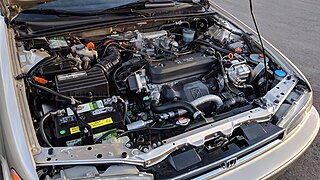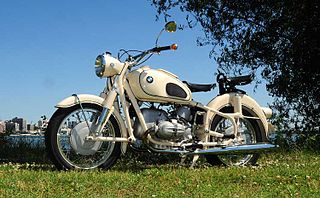The Honda XR series is a range of four-stroke off-road motorcycles that were designed in Japan but assembled all over the world.
The Y-block engine is a family of overhead valve V8 automobile engines produced by Ford Motor Company. The engine is well known and named for its deep skirting, which causes the engine block to resemble a Y. It was introduced in 1954 as a more modern replacement for the outdated side-valved Ford Flathead V8 and was used in a variety of Ford vehicles through 1964.

The Lamborghini V8 is a ninety degree (90°) V8 petrol engine designed by Lamborghini in the 1970s for their less-expensive vehicles. It was only the second internal combustion engine ever developed by the company, and first saw production for the 1971 Lamborghini Urraco. It was designed by Giampaolo Dallara. The all-aluminium alloy engine was introduced as a 2.5-litre variant, displacing 2,463 cc (150.3 cu in), but was expanded, by increasing the piston stroke to a 3.0-litre variant for 1975 - now displacing 2,997 cc (182.9 cu in).
The Honda B20A engine series, known as the B20A and B21A, was an inline four-cylinder engine family from Honda introduced in 1985 in the second-generation Honda Prelude. Also available in the contemporary third-generation Honda Accord in the Japanese domestic market, along with the Accord-derived Vigor, the B20A was Honda's second line of multivalve DOHC inline four-cylinder engines behind the "ZC" twin-cam variant of the ordinarily SOHC D-series, focused towards performance and displacing 2.0 to 2.1 litres.

The E-series was a line of inline four-cylinder automobile engines designed and built by Honda for use in their cars in the 1970s and 1980s. These engines were notable for the use of CVCC technology, introduced in the ED1 engine in the 1975 Civic, which met 1970s emissions standards without using a catalytic converter.

The Austin Motor Company A-series is a British small straight-4 automobile engine. Launched in 1951 with the Austin A30, production lasted until 2000 in the Mini. It used a cast-iron block and cylinder head, and a steel crankshaft with three main bearings. The camshaft ran in the cylinder block, driven by a single-row chain for most applications, and with tappets sliding in the block, accessible through pressed steel side covers for most applications, and with overhead valves operated through rockers. The cylinder blocks are not interchangeable between versions intended for conventional end-on mounted gearboxes and the 'in-sump' transaxle used on British Motor Corporation/British Leyland front wheel drive models such as the Mini. The cylinder head for the overhead-valve version of the A-series engine was designed by Harry Weslake – a cylinder head specialist famed for his involvement in SS (Jaguar) engines and several Formula One-title winning engines. Although a "clean sheet" design, the A-series owed much to established Austin engine design practise, resembling in general design and overall appearance a scaled-down version of the 1200cc overhead-valve engine first seen in the Austin A40 Devon which would form the basis of the later B-series engine.

The Nissan L series of automobile engines was produced from 1966 through 1986 in both inline-four and inline-six configurations ranging from 1.3 L to 2.8 L. It is a two-valves per cylinder SOHC non-crossflow engine, with an iron block and an aluminium head. It was the engine of the Datsun 510, Datsun 240Z sports car, and the Nissan Maxima. These engines are known for their reliability, durability, and parts interchangeability.

The Prince G-series engine was the company's only straight-four and straight-six engines which began production in 1955. A number of variations were made, with both OHV and OHC heads. A diesel four-cylinder with 1.9 L (1,862 cc) was also built, called the D-6. The G series was used in the Skyline, the Laurel, and the Gloria from the 1950s to the early 1970s.

The Honda D series inline-four cylinder engine is used in a variety of compact models, most commonly the Honda Civic, CRX, Logo, Stream, and first-generation Integra. Engine displacement ranges between 1.2 and 1.7 liters. The D Series engine is either SOHC or DOHC, and might include VTEC variable valve lift. Power ranges from 66 PS (49 kW) in the Logo to 130 PS (96 kW) in the Civic Si. D-series production commenced in 1984 and ended in 2005. D-series engine technology culminated with production of the D15B 3-stage VTEC (D15Z7) which was available in markets outside of the United States. Earlier versions of this engine also used a single port fuel injection system Honda called PGM-CARB, signifying the carburetor was computer controlled.

The Honda F-Series engine was considered Honda's "big block" SOHC inline four, though lower production DOHC versions of the F-series were built. It features a solid iron or aluminum open deck cast iron sleeved block and aluminum/magnesium cylinder head.

The Toyota KR engine family is a straight-3 piston engine, designed by Daihatsu, a subsidiary of Toyota. The 1KR series uses aluminium engine blocks and chain driven DOHC cylinder heads. It uses multi-point fuel injection, and has 4 valves per cylinder. Some versions have VVT-i variable valve timing. The engine is exceptionally light: 69 kg (152 lb) with all ancillaries.

The Suzuki GSX-R750 is a sports motorcycle made by Suzuki since 1984. It was introduced at the Cologne Motorcycle Show in October 1984 as a motorcycle of the GSX-R series for the 1985 model year.

The R69S, R69US, and R69 are motorcycles, fitted with 594 cc boxer twin engines, that were manufactured by BMW in Munich, Germany.

The BMW M78 is a petrol overhead valve straight-six engine which was produced from 1933 to 1950. It is the first straight-6 automobile engine produced by BMW, an engine layout which has been a key feature of the brand for many years since.

The Toyota NR engine family is a series of small inline-four piston engines designed and manufactured by Toyota, with capacities between 1.2 and 1.5 litres.
The Hirth F-23 is a twin cylinder, horizontally-opposed, two stroke, carburetted or optionally fuel injected aircraft engine designed for use on ultralight aircraft. It is manufactured by Hirth of Germany.
The Zenoah G-50 is a twin-cylinder, horizontally opposed, two stroke, carburetted aircraft engine, designed for use on ultralight aircraft.

The KFM 107 is a two-cylinder, two-stroke, single ignition, horizontally opposed aircraft engine designed for ultralight aircraft and motor gliders.
Ducati Bipantah was a prototype 90° V4 four-stroke motorcycle engine made by Ducati in 1981. It was designed by Pierluigi Mengoli under the supervision of Fabio Taglioni. It had four cylinders and made coupling two Ducati Pantah V-twin engines. It remained a prototype, although it had good results during dyno-tests. The project ended in late 1982, when then-owners VM Motori decided not to build the bike for which the motor was intended for.
The Ferrari flat-12 engine family is a series of flat-12 DOHC petrol engines produced by Ferrari from 1964 to 1996. The first racing Ferrari flat-12, the Mauro Forghieri-designed Tipo 207, was introduced in the Ferrari 1512 F1 car in 1964. Later flat-12 racing engines were used in Ferrari Formula One and sports racing cars from 1968 until 1980, including the 212 E Montagna, 312 B series, 312 PB and 312 T series. The roadgoing flat-12 engines were introduced with the 365 GT4 BB and were produced in various versions until the end of F512M production in 1996.














